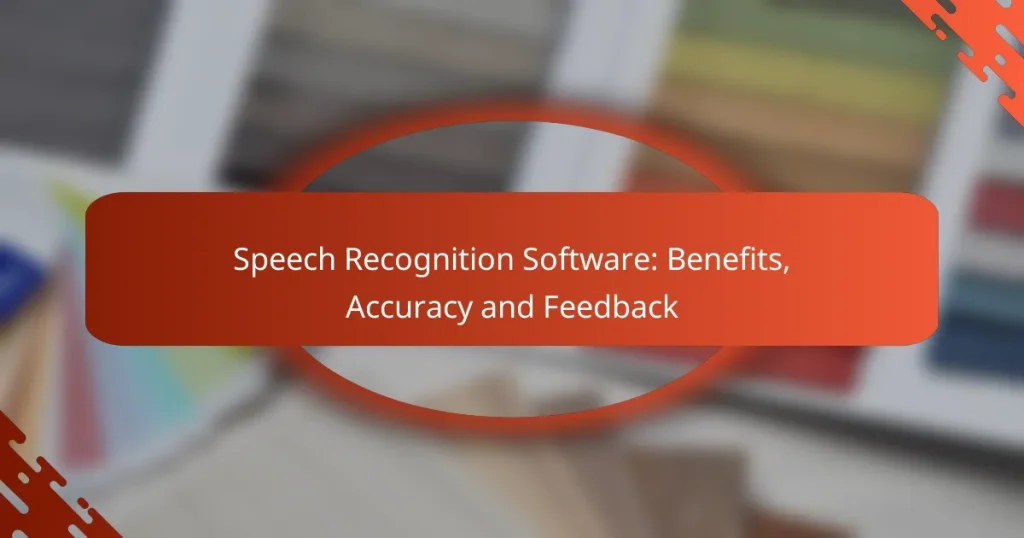Speech recognition software has become an essential tool, offering significant benefits such as increased efficiency and improved accessibility for individuals with disabilities. With accuracy rates often exceeding 95%, it enables effective communication and transcription across various settings. Additionally, built-in feedback mechanisms enhance user experience by providing valuable insights and corrections, ultimately improving performance over time.
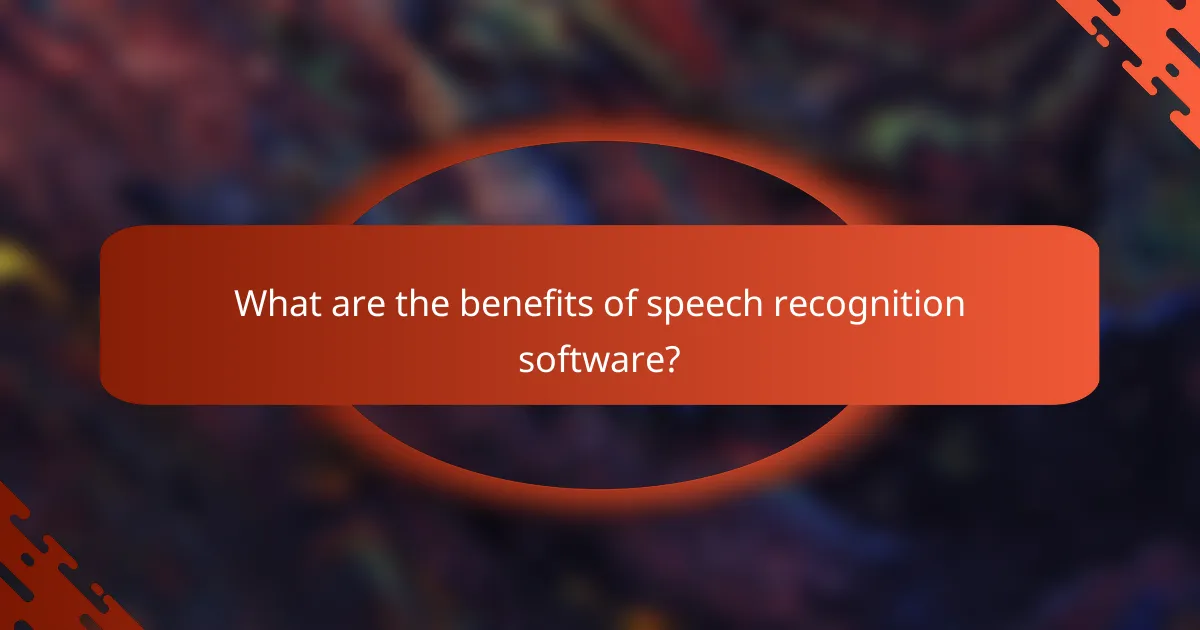
What are the benefits of speech recognition software?
Speech recognition software offers numerous advantages, including increased efficiency, improved accessibility for users with disabilities, and enhanced accuracy in transcription tasks. These benefits make it a valuable tool for both individuals and businesses looking to streamline communication and reduce costs.
Increased productivity
Speech recognition software can significantly boost productivity by allowing users to dictate text and commands instead of typing. This can save time, especially for tasks that involve extensive writing or data entry. For instance, professionals can complete reports or emails in a fraction of the time it would take to type them out manually.
Additionally, integrating speech recognition into workflows can minimize distractions and enhance focus, as users can multitask more effectively. By converting speech to text quickly, employees can maintain a steady flow of ideas without interruption.
Enhanced accessibility
Speech recognition technology plays a crucial role in enhancing accessibility for individuals with disabilities. It allows users with limited mobility or visual impairments to interact with devices and software more easily. For example, voice commands can enable hands-free operation of computers and smartphones, making technology more inclusive.
Moreover, many speech recognition tools are designed to support multiple languages and dialects, broadening access for non-native speakers. This inclusivity fosters a more diverse environment in workplaces and educational settings.
Improved accuracy in transcription
Modern speech recognition software has advanced significantly, achieving high levels of accuracy in transcription. Many systems can recognize various accents and adapt to different speech patterns, resulting in fewer errors. This accuracy is particularly beneficial in professional settings where precise documentation is essential, such as in legal or medical fields.
To maximize transcription accuracy, users should ensure clear speech and minimize background noise. Regularly updating the software can also enhance performance, as newer versions often include improved algorithms and features.
Cost savings for businesses
Implementing speech recognition software can lead to substantial cost savings for businesses. By reducing the time employees spend on manual data entry and document creation, companies can allocate resources more efficiently. This can translate into lower labor costs and increased output.
Additionally, businesses may save on training costs, as many speech recognition tools are user-friendly and require minimal onboarding. Investing in this technology can yield long-term financial benefits, especially for organizations with high volumes of documentation.
Real-time communication
Speech recognition software enables real-time communication, allowing users to convert spoken language into text instantly. This capability is particularly useful in meetings, conferences, and collaborative environments where immediate feedback is crucial. Participants can focus on discussions rather than note-taking, enhancing engagement and interaction.
Furthermore, real-time transcription can facilitate better understanding among multilingual teams by providing instant translations. This feature can bridge communication gaps and foster a more cohesive work environment.

How accurate is speech recognition software?
Speech recognition software typically achieves accuracy rates ranging from 80% to over 95%, depending on various factors such as the quality of the audio input and the specific software used. Users can expect varying performance in different environments and with different accents or languages.
Factors affecting accuracy
Several key factors influence the accuracy of speech recognition software. The clarity of the audio input is crucial; background noise, microphone quality, and speaker volume can significantly impact performance. Additionally, the software’s ability to understand different accents and dialects can lead to variations in accuracy.
Another important factor is the context in which the software is used. For example, specialized vocabulary in fields like medicine or law may reduce accuracy if the software is not trained on that specific terminology. Regular updates and training on diverse datasets can help improve recognition rates.
Comparison of leading software
When comparing leading speech recognition software, options like Google Speech-to-Text, Microsoft Azure Speech, and IBM Watson are often highlighted for their high accuracy and extensive language support. Google Speech-to-Text is known for its robust performance in real-time applications, while Microsoft Azure offers strong integration capabilities with other services.
IBM Watson, on the other hand, excels in industry-specific applications, particularly in healthcare. Users should consider their specific needs, such as language support and integration with existing systems, when choosing software.
Industry-specific performance
Speech recognition software can perform differently across various industries. In healthcare, for instance, specialized software can achieve accuracy rates exceeding 90% when transcribing medical dictations due to its tailored vocabulary and context. In contrast, general-purpose software may struggle with technical jargon.
In the legal field, software designed for legal terminology can significantly enhance transcription accuracy, making it easier to document proceedings or case notes. Users should evaluate software options based on their industry requirements to ensure optimal performance.
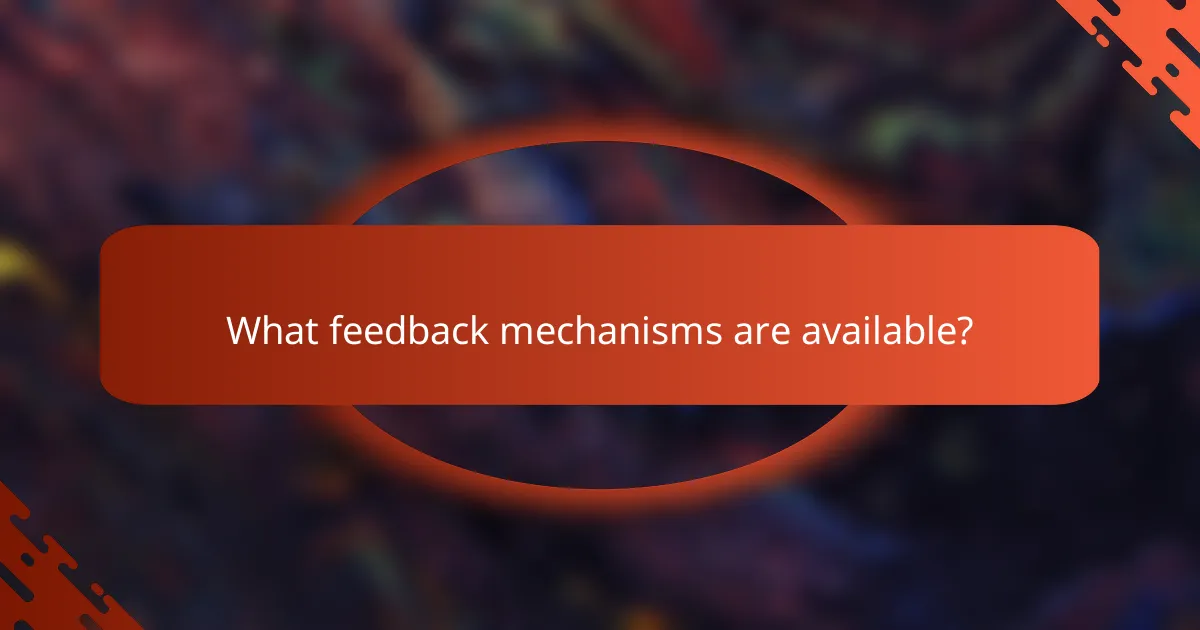
What feedback mechanisms are available?
Feedback mechanisms in speech recognition software enhance user experience by providing insights and corrections. These systems help users understand the software’s performance and improve accuracy over time.
User feedback systems
User feedback systems allow individuals to report inaccuracies or suggest improvements directly within the software. This feedback can be collected through simple interfaces, such as rating systems or comment boxes, enabling developers to refine algorithms based on real-world usage.
For example, users might indicate when the software misinterprets a word or phrase, which can help developers prioritize updates. Regularly engaging with these systems can lead to a more tailored experience and increased accuracy.
Integration with other tools
Integrating speech recognition software with other applications can streamline workflows and enhance functionality. For instance, linking it with word processors or customer relationship management (CRM) systems allows for seamless voice-to-text conversion, improving productivity.
Consider using software that supports APIs for easy integration. This can enable automatic updates and data sharing, which can significantly reduce manual entry errors and save time.
Real-time correction features
Real-time correction features enable users to make immediate adjustments to transcriptions as they speak. This functionality is crucial for maintaining accuracy, especially in professional settings where precision is vital.
For effective use, familiarize yourself with the correction commands specific to your software. Many systems allow users to simply say a command to correct a word or phrase, which can enhance overall efficiency and reduce frustration during dictation.
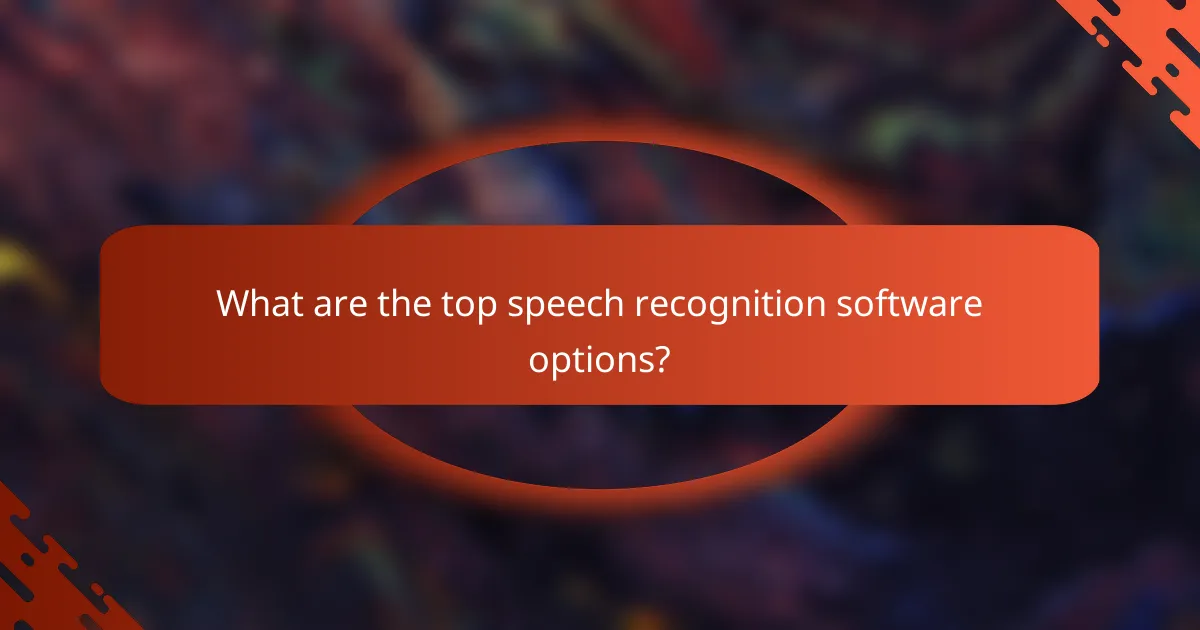
What are the top speech recognition software options?
The leading speech recognition software options include Dragon NaturallySpeaking, Google Speech-to-Text, and Microsoft Azure Speech Service. Each of these tools offers unique features and capabilities, catering to different user needs and environments.
Dragon NaturallySpeaking
Dragon NaturallySpeaking is a powerful speech recognition software known for its high accuracy and customization options. It is particularly favored by professionals in fields such as healthcare and legal, where precise terminology is crucial.
This software works by learning the user’s voice and speech patterns over time, improving its accuracy with continued use. Users can dictate documents, control applications, and even navigate the web using voice commands.
When considering Dragon, be aware of its system requirements and the need for a relatively quiet environment for optimal performance. It is available for a one-time purchase or subscription, which can vary in price depending on the version and features selected.
Google Speech-to-Text
Google Speech-to-Text is a cloud-based service that converts spoken language into text in real-time. It supports multiple languages and dialects, making it a versatile choice for global users.
This service utilizes advanced machine learning algorithms to enhance accuracy and can be integrated into various applications via API. It is particularly useful for developers looking to add speech recognition capabilities to their products.
While Google Speech-to-Text offers a pay-as-you-go pricing model, users should consider potential costs based on usage volume. It is ideal for applications requiring quick transcription or voice commands but may not be as customizable as standalone software like Dragon.
Microsoft Azure Speech Service
Microsoft Azure Speech Service provides a comprehensive suite of speech recognition tools as part of the Azure cloud platform. It is designed for developers and businesses looking to implement speech capabilities in their applications.
This service offers features such as real-time transcription, voice synthesis, and speaker recognition. It supports various languages and can be tailored to specific industry needs, making it a flexible option for enterprises.
Pricing is based on usage, and users should evaluate the costs associated with API calls and data processing. Azure Speech Service is particularly beneficial for organizations that require scalable solutions with robust security and compliance features.
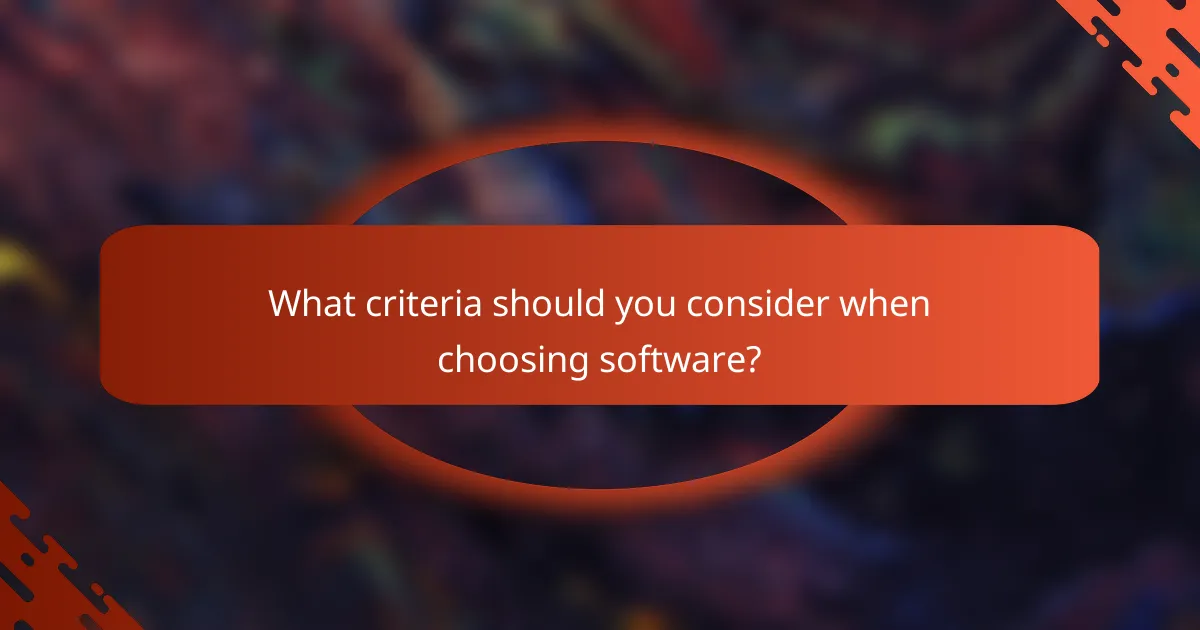
What criteria should you consider when choosing software?
When selecting speech recognition software, consider compatibility with existing systems, pricing models, and user interface. These factors will significantly impact usability, cost-effectiveness, and overall satisfaction with the software.
Compatibility with existing systems
Ensure the speech recognition software integrates seamlessly with your current technology stack. Check for compatibility with operating systems, applications, and hardware to avoid disruptions.
For example, if you use specific productivity tools like Microsoft Office or Google Workspace, confirm that the software supports those platforms. This can enhance workflow efficiency and reduce the need for additional training.
Pricing models
Evaluate the pricing structures available for the software, as they can vary widely. Common models include subscription-based, one-time purchase, or pay-per-use options.
Consider your budget and usage frequency. For instance, a subscription model may be more cost-effective for regular users, while occasional users might prefer a pay-per-use plan. Always look for hidden fees or additional costs associated with upgrades or customer support.
User interface and experience
The user interface (UI) and overall experience can greatly affect how effectively you use the software. A clean, intuitive UI can reduce the learning curve and enhance productivity.
Look for features like customizable settings, easy navigation, and responsive design. Reading user reviews can provide insights into how real users interact with the software, helping you make a more informed choice.

How does speech recognition software impact different industries?
Speech recognition software significantly enhances efficiency and accuracy across various industries by automating the transcription of spoken language into text. This technology streamlines workflows, reduces manual input errors, and improves accessibility, making it a valuable tool for many sectors.
Healthcare applications
In healthcare, speech recognition software is transforming patient documentation and clinical workflows. Physicians can dictate notes directly into electronic health records (EHR), saving time and allowing for more accurate patient interactions.
This technology helps reduce the administrative burden on healthcare professionals, enabling them to focus more on patient care. For instance, using speech recognition can cut documentation time by up to 50%, allowing for quicker patient assessments and treatment plans.
However, healthcare providers should ensure that the software complies with regulations like HIPAA in the U.S. to protect patient privacy. Regular training and updates are essential to maintain accuracy and adapt to medical terminology changes.
